|
Advantech MICA-071
Handy and amazingly competent 7-inch "Pocket Pad" for medical personnel
(by Conrad H. Blickenstorfer)
The healthcare industry must be one of the greatest opportunities for purveyors of ruggedized mobile computing systems, and also one of the most frustrating ones. It's a great opportunity because healthcare is a giant and rapidly growing industry, one with colossal needs for computing power in just about every area, and one where automation and information needs aren't even close to being met.
 But it's also a frustrating opportunity because, for one reason or another, acceptance and successful deployment of computing power in hospitals and other medical settings can be a painfully slow process, hampered by anything from budget cycles, to restrictive regulations (remember the "no cellphones!" signs everywhere?), to ingrained practices, turf wars, and much more. But it's also a frustrating opportunity because, for one reason or another, acceptance and successful deployment of computing power in hospitals and other medical settings can be a painfully slow process, hampered by anything from budget cycles, to restrictive regulations (remember the "no cellphones!" signs everywhere?), to ingrained practices, turf wars, and much more.
The healthcare market, though, is too large and too lucrative to give up on, and so all the major players in the computing industry keep trying. That includes Advantech which, for years now, has been offering various types of computing systems and platforms for the healthcare industry. Those include, in addition to the company's numerous embedded systems offerings, the PIT series of Patient Infotainment Terminals that deliver much more than what your standard hospital-issue wall-mounted dumb TV can offer, and also the MICA medical tablets.
Advantech's initial MICA product, the MICA-101 (see our review) was based on Intel's Mobile Clinical Assistant reference platform that was taken up by a good number of computer makers. In essence, Intel described a compact clipboard form factor, lightweight design, and an integrated handle so it would be easy to use and carry around during a work shift. The idea was that, along with appropriate software, an MCA tablet computer would enable clinicians to access patient care records at the point of care and document a patient's condition in real time. This, it was hoped, would result in fewer transcription errors, enhanced workflow, and quicker and safer patient care.
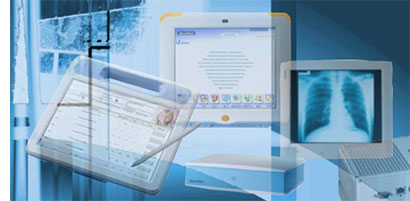 While the mobile clinical assistant concept was somewhat successful, it failed to become the ubiquitous go-to standard Intel probably had envisioned. Not even the US Federal Economic Stimulus legislation back in 2009 with its U$20 billion earmarked to modernize health care systems with the goal of switching to electronic patient records for all Americans by the year 2014 could help that. While the mobile clinical assistant concept was somewhat successful, it failed to become the ubiquitous go-to standard Intel probably had envisioned. Not even the US Federal Economic Stimulus legislation back in 2009 with its U$20 billion earmarked to modernize health care systems with the goal of switching to electronic patient records for all Americans by the year 2014 could help that.
So why did the MCA platform not work out as planned? In part because the iPhone and the iPad happened. The iPhone started the smartphone revolution that essentially placed a powerful connected computer into the hands of literally billions. The iPad established the tablet form factor as the new, convenient computing platform of choice, but minus the price and bulk of earlier efforts at tablet computers. Which meant that a lot of corporate and enterprise customers, including those in the healthcare industry, simply bought inexpensive consumer handhelds and tablets instead.
The problem with that is that consumer products are just that, products built for consumers. They are not tools for specialized jobs. They are designed to look cool and sexy, but they can't handle spills and drops. And they certainly don't include the data collection functionality required in most jobs.
A smaller, handier medical tablet
And that is why Advantech came up with the MICA-071. It's a small, slender tablet with a 7-inch screen. The kind that's (for now anyway) still a good deal larger than even the largest phones, but also much smaller and handier and lighter than an iPad or any other "full-size" tablet. And it includes the toughness and data collection tools for actual work in the field, in this case healthcare. Below is a close-up look at the MICA-071.
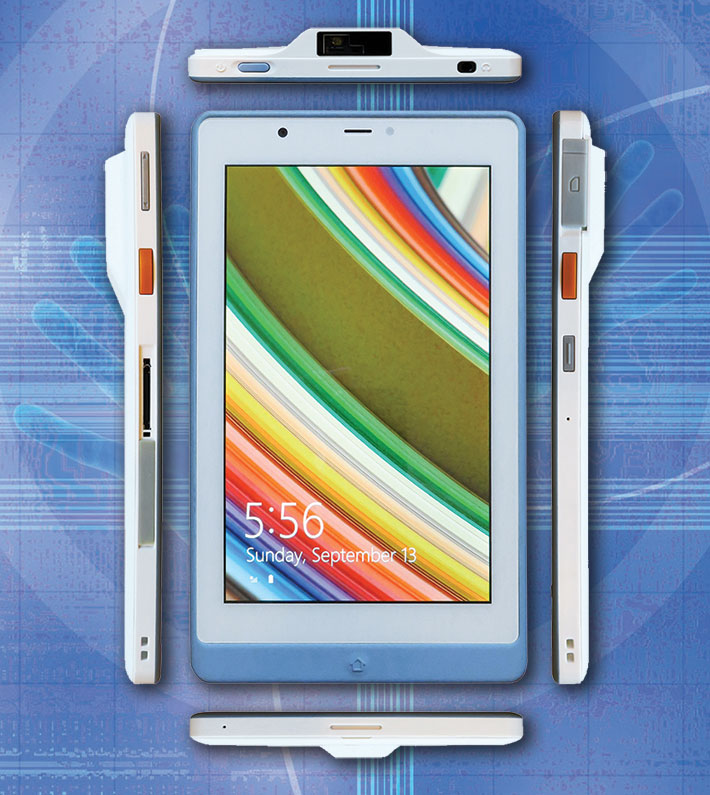
While the MICA-101 Mobile Clinical Assistant was certainly portable, its 3.5 pound weight and fairly large size meant it was often used as a mobile workstation on a cart. Sure, the tablet could easily be removed from its dock and carried around when needed, but it wasn't something that medical staff could just stick into a pocket and take along on their jobs.
 The MICA-071, on the other hand, is small and light enough to be carried around all day. It weighs just 16 ounces, but Advantech might be a bit optimistic calling it a "Pocket Pad" as the MICA-071 is still a good deal larger than today's plus-size smartphones. That means it won't fit into any old pocket but it can certainly be carried around in a lab frock pocket. The MICA-071, on the other hand, is small and light enough to be carried around all day. It weighs just 16 ounces, but Advantech might be a bit optimistic calling it a "Pocket Pad" as the MICA-071 is still a good deal larger than today's plus-size smartphones. That means it won't fit into any old pocket but it can certainly be carried around in a lab frock pocket.
The MICA-071's footprint is about the same as that of a Google Nexus 7 tablet. Since the size of this new Advantech medical tablet is likely to be a major selling and decisionmaking point, the comparison picture below shows exactly where the MICA-071 fits in in terms of size. From left to right are an Apple iPhone 6 Plus, a Google Nexus 7, the Advantech MICA-071, an Apple iPad Air 2, and Advantech's MICA-101.
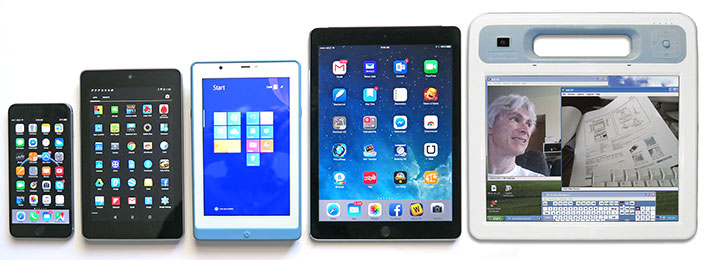
Now, obviously, Advantech wasn't going to make just another generic small tablet. It had to be something that was designed specifically for the healthcare market, and equipped with features that market requires, and optimized for use and handling in healthcare settings.
Before we go into those special requirements, I need to emphasize just how much the runaway success of smartphones and consumer tablets has changed user expectations. In the not-so-distant past, pretty much all that vertical market computing devices had to do was not fall apart while performing the job they were built for. Good industrial design, ease-of-use, state-of-the-art technology, and the latest features available in consumer tech were not a requirement. That has changed. Vertical market tablets, for example, are expected to have the same projected capacitive multi-touch as consumer devices, they must have the same state-of-the-art processing speed, features, ease of use, and communications capabilities. And attractive design certainly helps.
But beyond that, what are those design considerations specific to medical platforms?
- Ease of cleaning -- Since healthcare and other clinical environments rely on absolute cleanliness and frequent disinfection to prevent the spread of disease, the case must be sealed and should not have a lot of indents and openings that would make it difficult to clean and wipe.
- Minimizing infection potential -- The outside should be made of a chemical-resistant resin so that it holds up to frequent cleaning.
- Ruggedness -- Unlike fragile consumer electronics that rely on third party cases, professional users demand that their products hold up to typical use and potential mishaps on the job. That means good sealing and rugged construction.
- Scanning -- Healthcare computing devices require fast, accurate scanning. That means industrial-grade integrated 1D/2D barcode scanners, and not just an app for the onboard camera.
- Imaging -- Cameras integrated into vertical market/rugged devices have traditionally been weak. That won't do in medical settings.
Since medical tablets won't likely be used away from their dock for extended periods of time, battery life should be good, but not at the expense of a massive battery that'd make the device too heavy. Touch operation and digital ink allow annotations, scribbles, drawings, or even handwriting recognition. Medical tablets should have 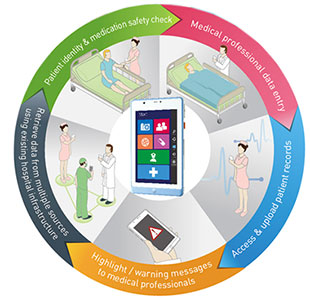 fast WiFi and Bluetooth for communication, and an RFID/NFC reader that can be used for rapid and reliable caregiver and patient identification as well as for the tracking of medication and supplies. fast WiFi and Bluetooth for communication, and an RFID/NFC reader that can be used for rapid and reliable caregiver and patient identification as well as for the tracking of medication and supplies.
What are small medical tablets designed to be used for? In essence to have access to patients' medical records and other clinical data throughout the healthcare facility. That may include:
- Data entry -- It must be easy to add bedside and other patient data.
- Upload and download -- Quick and reliable data viewing and upload must be possible.
- Alerts -- Device must be able to effectively alert to emergency conditions.
- Compatibility -- Device must easily integrate to existing infrastructure.
- Patient identity and safety checks -- Ability to accurately identify patient, medications, schedules.
Advantech's implementation of a medical "Pocket Pad"
A few years ago when most MCAs on the market were interpretations of the Intel reference design, they all looked quite similar. Only when you looked more closely did you see differences substantial enough to tilt a purchasing decision toward one product or another. Today, the same could be said for consumer tablets, as all of them roughly look the same. Given the extra requirements put upon a medical tablet, however, it's quickly obvious how the MICA-071 is different from your average consumer tablet.
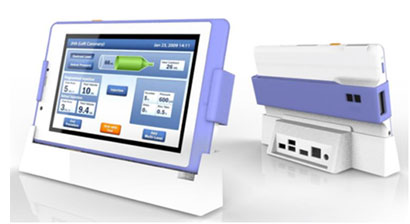 While almost all consumer tablets are either glossy black or some sort of shiny metallic, the MICA-071 is white plastic with a light-blue bezel. Advantech has long been using this color combination for their medical computing gear. While almost all consumer tablets are either glossy black or some sort of shiny metallic, the MICA-071 is white plastic with a light-blue bezel. Advantech has long been using this color combination for their medical computing gear.
And while smartphones and consumer tablets cannot be sleek and thin enough, the better part of the MICA-071 tablet is a workmanlike 0.57 inches thick, with the bulge that houses the scanner adding maximum thickness close to an inch. All this relative thickness made it easy for Advantech to place the various controls and ports a tool for the job needs, and it's also the reason the MICA weighs about a pound, more than the much larger iPad Air 2.
There's 4GB of RAM, which is what Windows 8.1 needs to run without getting bogged down, and 32GB of eMMC disk. eMMC is similar to memory cards and USB sticks as both are flash storage, but the controllers and chips used in SSDs are faster and much more sophisticated than those use with eMMC.
Since infection control is a major issue in clinical settings and staff needs to frequently spray and wipe the unit with disinfectant, all surfaces are smooth, all buttons are sealed, and there are as few openings as possible. The MICA-071 can be cleaned with alcohol-based cleaning agents without getting damaged.
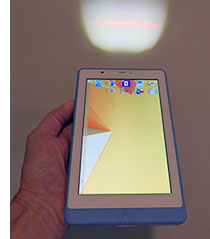 There aren't any onboard ports as all wired connectivity is provided via the MICA-071's dock. The dock offers HDMI, RJ45 LAN, two USB 2.0 ports, and a USB 3.0 port. There is a micro SD card slot on the unit, there's a microphone, a speaker, two scanner buttons, a volume control rocker, and a single programmable key to call up a major function. There aren't any onboard ports as all wired connectivity is provided via the MICA-071's dock. The dock offers HDMI, RJ45 LAN, two USB 2.0 ports, and a USB 3.0 port. There is a micro SD card slot on the unit, there's a microphone, a speaker, two scanner buttons, a volume control rocker, and a single programmable key to call up a major function.
On the wireless side there is dual-band 802.11a/b/g/n WiFi, Bluetooth 4.0, GPS and also NFC (Near Field Communication) for easy identification tasks. There's an embedded industrial-grade Intermec 1D/2D barcode scanner.
The MICA-071's 7-inch display offers 1280 x 800 pixel resolution. That's about 216 dots per inch, as much as Apple's "retina" 5k iMac 27, and in the same range as Microsoft's Surface Pro 2 and Surface Pro 3, both known for their exceptional sharpness. The MICA display is super-sharp for sure, and very bright as well. In fact, most users will likely need to play with the Windows interface and size settings, or else text is too tiny for most. That's not an issue for the custom medical software most MICAs will be running, and it also makes for super-sharp images.
The MICA-071 has a capacitive multi-touch interface that's very responsive. Smartphone users are able to tap and pan and pinch and zoom to their hearts' delight, but operating classic Windows with its tiny scrollers and check boxes and menus is a task best left to a mouse. Even the supplied capacitive stylus is overmatched, despite its relatively narrow 6mm tip.
Intel "Bay Trail" — supercharging the Atom
What's under the hood of the Mica-071? That's a loaded question in an era where customers demand both rock-bottom pricing and stellar performance. The consumer electronics industry is now offering quite competent $99 tablets while a bare Intel Core processor alone can cost several times as much. In the past, industrial and embedded computing manufacturers kept costs down by using Intel Atom processors that could be had for a fraction of a Core chip's price.
That often backfired as early Atom chips were painfully slow, to the extent where they almost singlehandedly killed the once promising netbook market. To further to illustrate that predicament, witness the number of industrial computing platforms that bet on Atom, quickly updated to every new Atom chip, but eventually gave up on Atom and accepted the higher cost of Intel's high-end Core processors. They had no choice.
It wasn't until the advent of Intel's "Bay Trail" platform a couple of years ago that things changed. Bay Trail represented a vast improvement over earlier generations of Atom processors, to the extent where Intel actually markets Bay Trail chips under the Pentium and Celeron brands in addition to the Atom brand. 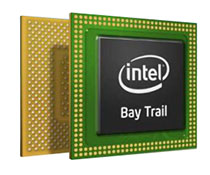 The Bay Trail CPU architecture employs advanced 22nm process technology, and the graphics cores integrated into Bay Trail systems are of the same HD Graphics architecture and variety as those used in Intel's 3rd generation "Ivy Bridge" processors, albeit with fewer execution units (four instead of several times that number) and lower clock speeds. The Bay Trail CPU architecture employs advanced 22nm process technology, and the graphics cores integrated into Bay Trail systems are of the same HD Graphics architecture and variety as those used in Intel's 3rd generation "Ivy Bridge" processors, albeit with fewer execution units (four instead of several times that number) and lower clock speeds.
All the above means that the 1.46GHz quad-core Intel "Bay Trail" Atom Z3770 processor in the MICA-071 is most definitely not your father's Atom. It can reach burst speeds up to 2.4GHz. It includes some of the clever power-saving features of Intel's 4th generation Haswell Core processors. And its overall performance is lightyears ahead of the old Atom Z530 that powered the original Advantech MICA-101 MCA.
To determine just how quick the MICA-071 is, we installed Passmark Software's PerformanceTest 6.1 on the little medical tablet. Passmark's benchmark suite runs about 30 tests covering CPU, 2D graphics, 3D graphics, memory, and disk and then computes scores for each category and an overall PassMark score. We also ran the more single-core oriented CrystalMark as a cross-check. Just to provide an idea of how other Intel processor platforms perform that Advantech uses in some of their other products, we included not only the old MICA-101, but also the Intel Celeron J1900-based ARK-2121L Box PC, and the desktop-class AIIS-1240 optical inspection system. The results were as follows:
|
Advantech MICA-071 Benchmarks and Comparisons
|
|
PERFORMANCE COMPARISON
|
Advantech
|
Advantech
|
Advantech
|
Advantech
|
|
Model
|
MICA-071
|
MICA-101
|
ARK-2121L
|
AIIS-1240
|
|
Model (click pic for review)
|

|

|

|

|
|
Year tested
|
2015
|
2009
|
2015
|
2014
|
|
Intel Core processor
|
Atom Z3770
|
Atom Z530
|
Celeron J1900
|
Core i7-3770
|
|
CPU Speed
|
1.46/2.40GHz
|
1.60GHz
|
2.00/2.42GHz
|
3.40/3.90GHz
|
|
OS Software
|
WES8
|
Win XP
|
WES7
|
WES7
|
|
Thermal Design Power (TDP)
|
2.0 watts
|
2.3 watts
|
10 watts
|
77 watts
|
|
CPU Mark
|
2,183.8
|
256.1
|
2,422.2
|
8,820.9
|
|
2D Graphics Mark
|
147.0
|
112.6
|
209.0
|
696.5
|
|
Memory Mark
|
464.2
|
226.9
|
616.7
|
1,420.5
|
|
Disk Mark
|
427.8
|
215.5
|
2,558.0
|
519.5
|
|
3D Graphics Mark
|
117.2
|
11.5
|
139.3
|
476.4
|
|
Overall PassMark
|
793.4
|
170.2
|
1,305.9
|
2,895.9
|
|
CM ALU
|
29,600
|
5,366
|
33,069
|
84,049
|
|
CM FPU
|
25,664
|
4,654
|
26,899
|
68,910
|
|
CM MEM
|
27,301
|
3,917
|
20,558
|
47,498
|
|
CM HDD
|
14,130
|
3,837
|
36,874
|
8,325
|
|
CM GDI
|
5,654
|
2,269
|
6,477
|
17,856
|
|
CM D2D
|
3,243
|
211
|
3,983
|
8,411
|
|
CM OGL
|
3,503
|
325
|
3,982
|
10,417
|
|
Overall CrystalMark
|
109,095
|
20,579
|
131,842
|
245,466
|
What's instantly obvious in the table above is the vast, vast performance increase of the MICA-071 over the original version of the MICA-101 MCA. In an era where Intel often celebrates a 15% increase from one generation to the next, the small MICA-071 tablet is literally FIVE TIMES as fast as the MICA-101 was when it was first launched six years ago.
What's also quite interesting is how well the MICA-071's Atom Z3770 platform holds up against the higher-end fellow Bay Trail Celeron J1900. The J1900 has become a popular workhorse chip in industrial and embedded systems, but you can see that if it weren't for the relatively slow eMMC mass storage in the MICA tablet, it'd be a rather close race.
It's also clear, though, that despite the vast progress Bay Trail represents, Intel's expensive, heavy-duty Core processor iron is still leagues ahead. Just look at the numbers Advantech's AIIS-1240 optical inspection system pulls, and that's even with comparatively slow hard disks. There is a need and place for all sorts of processors, but it should be clear now just how far the "Bay Trail" class of very cost-effective processors has come.
Power and battery life
Maximum battery life is not the same top priority in a clinical indoor environment as it is for machines that will always be used out in the field, but it's still good to know that the machine won't run quickly out of juice if it's away from its dock or charger. As is, the MICA-071 has a modest 16.2 watt-hour battery that's not user-accessible and thus relies on recharging rather than a quick battery swap. Advantech is a bit vague on battery life, stating 4 to 6 hours of "heavy" use, or 6 to 8 hours of "normal" use.
To check the little tablet's power draw we used PassMark's BatteryMon software. 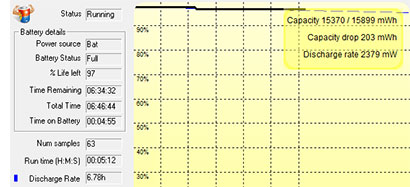 The MICA only allows for one Windows power, the "Balanced" one. The MICA only allows for one Windows power, the "Balanced" one.
With WiFi and Bluetooth on and the display at low brightness, the MICA-071 drew a minuscule 2.2 watts. This translates into a theoretical battery life of 7.4 hours.
With the brightness cranked all the way up, we still only recorded 3.5 watts, good for a theoretical 4.6 hours.
This indicates that Advantech's estimates are quite achievable achievable, especially since power draw doesn't seem to go up much under most loads.
Now here's an amazing thing: when we tested the original and much less powerful MICA-101 with its anemic Atom Z530 chip, we saw a minimum of 8.9 watts of power draw. So the MICA-071 is 5 times faster, but its minimal power draw is 4 times less. We're taking major progress here.
This being a fanless design, the MICA-071 relies on good thermal management to dissipate whatever heat its miserly circuitry generates. If you wonder what is inside the plastic housing, we don't know. The back plate is held in place with numerous little plastic snaps and some other invisible retainers, and we didn't want to break any of those.
Excellent cameras
The MICA-071 comes with two cameras. The one in the front has 2mp resolution, i.e. 1920 x 1080. That's more than the 1280 x 800 pixels the screen displays. 1920 x 1080 is the display resolution of the vast majority of current HDTVs, so if 1920 x 1080 looks "high definition" on a giant 60-inch TV, you can imagine how sharp it is on a much smaller screen.
The documentation camera in the back has 8mp resolution, which translates into 3264 x 2448 pixel. Users of many modern smartphones may sneer at that as their techno marvels have 12 or 16mp cameras or more. But consider that 8mp is roughly 4k TV resolution, and it's also what Apple still had in its iPhone 6 and 6 Plus, until the very latest 6S and 6S Plus went up to 12mp.
Unfortunately, megapixel only means so much. We've seen more than our share of very disappointing internal cameras in industrial and rugged handhelds and tablets, cameras that were barely usable. We're happy to report that the MICA-071's cameras are not only good, they are excellent.
The pictures below are quick snapshots taken with the MICA-071's documentation camera. The camera is fast, you can go quite close for details, and the pictures are vibrant and not overly compressed. Click on the image below for a full-size version.

The documentation camera, by the way, does flawless full 1080p 1920 x 1080 pixel video as well.
Overall impressions: Advantech MICA-071
Those familiar with the various Intel reference platform Mobile Clinical Assistants out there will likely agree that those older designs feel rather big and heavy in this new era of super-slim consumer tablets and hyper-tech smartphones. So trying something smaller like this MICA-071 tablet makes sense. It's really not a "Pocket Pad" 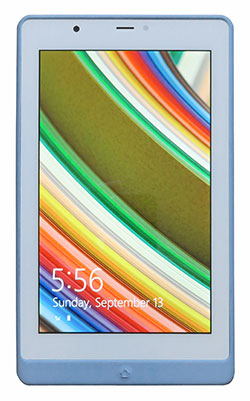 as it's neither a pad nor truly pocketable. It is, however, a very nicely made little tablet that's a far more serious power tool than its rather innocuous pale-blue and white plastic body makes you think. as it's neither a pad nor truly pocketable. It is, however, a very nicely made little tablet that's a far more serious power tool than its rather innocuous pale-blue and white plastic body makes you think.
The screen's terrific. It's super-sharp, has a perfect viewing angle without any color shifts, and it's wonderfully vibrant. About the only problem here is that it's so sharp as to render the notoriously unscalable Windows a bit of a bear to use.
Performance is exceptional, too. The Intel Z3770 chip is more than up to the job, and even with the not-so-fast eMMC storage, this tablet is very quick and never falls behind. Then there's the industrial-quality scanner and those amazingly good cameras.
In terms of ruggedness, the MICA is built for the job at hand. It feels tight and solid and can handle a 3-foot drop (and we think probably more). IP54 sealing should be plenty good enough (the "5" stands for almost total protection against dust, and the "4 for protection against water spray from all directions). The 32 to 104 degree Fahrenheit operating temperature is also sufficient for the intended indoor operation range.
Which gets us to the price. That, according to the Advantech Online store, is US$1,450, which is a wee-bit on the dear side. Then again, this is healthcare we're talking about, and compared to the utterly insane cost of anything in a hospital, it's, by comparison, actually a terrific bargain. -- Conrad H. Blickenstorfer, September 2015
Advantech MICA-071 Specs:
| Type |
Compact medical tablet computer
|
| Processor |
1.46 GHz Intel "Bay Trail" Atom Z3770 |
| OS |
Windows 8.1 Industry Pro
|
| Memory |
4GB LPDDR3 |
| Display |
7.0" XGA (1280 x 800) TFT LCD |
| Digitizer |
10-point projected capacitive multi-touch |
| Keyboard |
Optional external USB |
| Storage |
32GB eMMC
|
| Expansion slots |
Micro SD card
|
| Housing |
Disinfectant-resistant plastic housing with magnesium-alloy internal frame |
| Size |
7.9 x 4.8 x 0.57 to 0.94 inches (200 x 121 x 14.5 to 24 mm) |
| Weight |
1.0 pounds as tested, with battery (460 grams)
|
| Operating temperature |
32 to 104 degrees Fahrenheit (0° to 40°C |
| Ingress protection |
IP54 |
| Drop |
3-foot drop |
| Vibration |
NA |
| Humidity |
10-95% non-condensing |
| Power |
Li-Ion 3.7V/4,100mAh 16.17 watt-hour Li-Ion ("6 to 8 hours normal use") |
| Cameras |
front: 2mp vidcam, rear: 8MB auto-focus with flash |
| Scanning |
Honeywell Intermec EA31 1D/2D barcode scanner |
| Interface |
1 x line-out audio, docking connector for 1 x HDMI, 2 x USB 2.0, 1 x USB 3.0, 1 x RJ45 LAN, power
|
| Wireless options |
802.11a/b/g/n, Bluetooth V4.0/EDR, GPS, NFC
|
| Price |
depends on configuration |
| Contact |
Advantech www.advantech.com.tw |
| Contact |
Advantech Corporation
13 Whatney
Irvine, CA 92618
Toll Free: 1-800-866-6008
Ph: 949-420-2500
Fax: 949-420-2501
ECGInfo@advantech.com
www.advantech.com
|
Advantech Co. Ltd.
No.1, Alley 20, Lane 26, Rueiguang Road
Neihu District, Taipei Taiwan 114, R.O.C.
Tel: 886-2-2792-7818
Fax: 886-2-2794-7301
www.advantech.com
|
|



